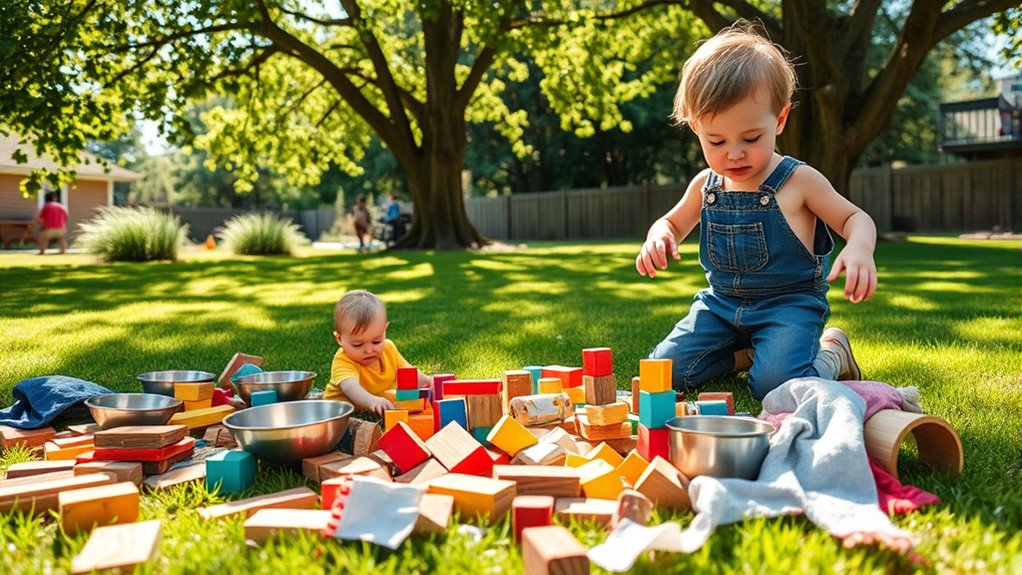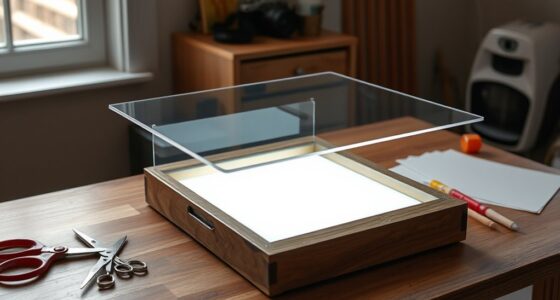To create setups that spark imagination with loose parts play, gather safe, everyday objects like stones, fabric, and blocks and arrange them in accessible, open-ended ways. Let children explore freely, encouraging them to build, invent, and experiment without strict rules. This environment fosters curiosity, problem-solving, and sensory engagement, helping kids develop confidence and critical thinking. Keep exploring different combinations and materials to keep their creativity flowing and see what endless possibilities unfold.
Key Takeaways
- Use varied, everyday objects like stones, fabric, and sticks to create inviting, accessible play areas.
- Arrange materials in open, spacious setups to encourage free exploration and creativity.
- Incorporate sensory-rich items with different textures and colors to enhance tactile engagement.
- Set up themed environments such as castles or landscapes to inspire imaginative storytelling.
- Ensure materials are safe, durable, and organized for easy access, promoting independent, open-ended play.

Loose parts play invites children to explore, create, and problem-solve using simple, movable materials like blocks, stones, or fabric. When you set up these open-ended opportunities, you’re encouraging not just play but a rich experience of discovery. Children are free to manipulate the materials in countless ways, which promotes open-ended exploration. They might stack stones into towers, arrange fabric into tunnels, or combine different objects to build something entirely new. This freedom sparks their curiosity and allows them to test their ideas without strict rules or predetermined outcomes. Because the materials are versatile, children can approach the activity from multiple angles, fostering creativity and critical thinking. Additionally, incorporating beneficial ingredients like collagen and hyaluronic acid in related products can enhance sensory experiences and skin benefits during play or self-care routines. Sensory engagement is a significant aspect of loose parts play. When kids handle different textures, shapes, and weights, they activate their senses in meaningful ways. Soft fabrics, rough stones, and smooth blocks each provide tactile feedback that helps children refine their sensory perceptions. This kind of engagement supports their development by enhancing hand-eye coordination, fine motor skills, and spatial awareness. As they feel the weight of a stone or the squishiness of fabric, they’re not just playing—they’re also learning how different materials respond to touch. You can enhance sensory engagement by intentionally selecting a variety of textures and colors, encouraging children to explore with all their senses, which deepens their understanding and connection to the materials. Setting up loose parts play is straightforward and adaptable to any space. You don’t need elaborate equipment—just gather everyday objects that are safe and durable. Once you have your materials, place them in accessible areas where children can freely choose what to use. The open-ended nature of this setup invites children to experiment, imagine, and innovate at their own pace. They might create a castle, design a landscape, or invent a new game, all driven by their interests. As they manipulate the materials, they develop problem-solving skills, learn about balance and structure, and build confidence in their ideas. Your role is to observe and support, offering encouragement without dictating how play should unfold. Ultimately, loose parts play is about providing a flexible, engaging environment that nurtures curiosity, sensory exploration, and imaginative thinking. When you create setups that emphasize open-ended exploration, you give children the space to discover their capabilities and express their creativity. This type of play not only entertains but also lays the foundation for lifelong learning and a love of discovery.
Frequently Asked Questions
How Do I Start Incorporating Loose Parts Into My Child’s Daily Routine?
You can start incorporating loose parts into your child’s daily routine by setting up simple, accessible areas with various natural or recycled items like stones, fabric, and sticks. Encourage their imaginative exploration by asking open-ended questions and allowing them to manipulate the materials freely. This promotes sensory engagement and creativity. Make it a regular part of playtime, and watch how their problem-solving skills and imagination flourish naturally.
Are There Safety Concerns With Certain Loose Parts?
Did you know that 65% of childhood injuries relate to play activities? When considering loose parts, safety concerns are valid. You should always assess hazard awareness and material safety before introducing new items. Avoid small parts that pose choking risks, sharp edges, or toxic materials. Regularly inspect loose parts for damage. By staying vigilant, you guarantee play remains fun and safe, fostering creativity without unnecessary risks.
How Can I Encourage Creative Play Without Directing It?
You can encourage creative play by asking open-ended questions that inspire child-led exploration, like “What can you make with these?” or “How do you want to use these?” Let children choose and arrange loose parts freely, providing minimal guidance. Watch how they experiment and imagine, stepping back to support their independence. This approach nurtures their creativity while ensuring they feel in charge of their play.
What Are Cost-Effective Ways to Gather Loose Parts?
Think of gathering loose parts as treasure hunting—you’ll find gems in everyday items. Use DIY collections from recycled materials like bottle caps, fabric scraps, and cardboard boxes. Visit local thrift stores or ask families for donations, turning everyday clutter into creative play essentials. These cost-effective methods turn simple, recycled items into a treasure trove that sparks imagination without breaking the bank.
How Does Loose Parts Play Support Different Developmental Stages?
You support different developmental stages through loose parts play by encouraging cognitive development and emotional resilience. As you provide diverse materials, children explore and solve problems, boosting their critical thinking. They also learn to manage emotions and adapt to challenges, building emotional resilience. This flexible, open-ended play allows kids to develop at their own pace, fostering confidence and independence while nurturing essential skills across all ages.
Conclusion
As you watch children transform simple loose parts into worlds of their own, you see more than play—you see potential. These versatile pieces symbolize endless possibilities, inviting imagination to flourish without boundaries. By fostering environments where these parts are free to inspire, you’re nurturing creativity and resilience. Just like a seed holds the promise of a towering tree, loose parts hold the power to cultivate tomorrow’s thinkers, dreamers, and creators—if you let them play freely.










